Phylogenetic relationships and the evolution of regulatory gene sequences in the parrotfishes
- PMID: 18621133
- PMCID: PMC3418665
- DOI: 10.1016/j.ympev.2008.06.008
Phylogenetic relationships and the evolution of regulatory gene sequences in the parrotfishes
Abstract
Regulatory genes control the expression of other genes and are key components of developmental processes such as segmentation and embryonic construction of the skull in vertebrates. Here we examine the variability and evolution of three vertebrate regulatory genes, addressing issues of their utility for phylogenetics and comparing the rates of genetic change seen in regulatory loci to the rates seen in other genes in the parrotfishes. The parrotfishes are a diverse group of colorful fishes from coral reefs and seagrasses worldwide and have been placed phylogenetically within the family Labridae. We tested phylogenetic hypotheses among the parrotfishes, with a focus on the genera Chlorurus and Scarus, by analyzing eight gene fragments for 42 parrotfishes and eight outgroup species. We sequenced mitochondrial 12s rRNA (967 bp), 16s rRNA (577 bp), and cytochrome b (477 bp). From the nuclear genome, we sequenced part of the protein-coding genes rag2 (715 bp), tmo4c4 (485 bp), and the developmental regulatory genes otx1 (672 bp), bmp4 (488bp), and dlx2 (522 bp). Bayesian, likelihood, and parsimony analyses of the resulting 4903 bp of DNA sequence produced similar topologies that confirm the monophyly of the scarines and provide a phylogeny at the species level for portions of the genera Scarus and Chlorurus. Four major clades of Scarus were recovered, with three distributed in the Indo-Pacific and one containing Caribbean/Atlantic taxa. Molecular rates suggest a Miocene origin of the parrotfishes (22 mya) and a recent divergence of species within Scarus and Chlorurus, within the past 5 million years. Developmentally important genes made a significant contribution to phylogenetic structure, and rates of genetic evolution were high in bmp4, similar to other coding nuclear genes, but low in otx1 and the dlx2 exons. Synonymous and non-synonymous substitution patterns in developmental regulatory genes support the hypothesis of stabilizing selection during the history of these genes, with several phylogenetic regions of accelerated non-synonymous change detected in the phylogeny.
Figures
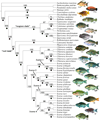
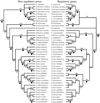
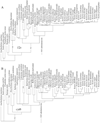

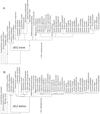

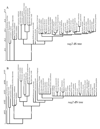
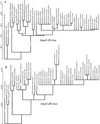

Similar articles
-
Phylogenetic relationships and evolutionary history of the reef fish family Labridae.Mol Phylogenet Evol. 2005 Aug;36(2):370-90. doi: 10.1016/j.ympev.2005.02.001. Mol Phylogenet Evol. 2005. PMID: 15955516
-
Phylogenetic relationships and the evolution of BMP4 in triggerfishes and filefishes (Balistoidea).Mol Phylogenet Evol. 2016 Jan;94(Pt A):397-409. doi: 10.1016/j.ympev.2015.09.014. Epub 2015 Sep 25. Mol Phylogenet Evol. 2016. PMID: 26408967
-
Dating the evolutionary origins of wrasse lineages (Labridae) and the rise of trophic novelty on coral reefs.Mol Phylogenet Evol. 2009 Sep;52(3):621-31. doi: 10.1016/j.ympev.2009.05.015. Epub 2009 May 21. Mol Phylogenet Evol. 2009. PMID: 19464378
-
Phylogenetic investigations of Antarctic notothenioid fishes (Perciformes: Notothenioidei) using complete gene sequences of the mitochondrial encoded 16S rRNA.Mol Phylogenet Evol. 2004 Sep;32(3):881-91. doi: 10.1016/j.ympev.2004.01.002. Mol Phylogenet Evol. 2004. PMID: 15288063
-
Exploring the radiation of a diverse reef fish family: phylogenetics of the damselfishes (Pomacentridae), with new classifications based on molecular analyses of all genera.Mol Phylogenet Evol. 2009 Jul;52(1):1-16. doi: 10.1016/j.ympev.2008.12.010. Epub 2008 Dec 24. Mol Phylogenet Evol. 2009. PMID: 19135160
Cited by
-
Historical factors that have shaped the evolution of tropical reef fishes: a review of phylogenies, biogeography, and remaining questions.Front Genet. 2014 Nov 13;5:394. doi: 10.3389/fgene.2014.00394. eCollection 2014. Front Genet. 2014. PMID: 25431581 Free PMC article. Review.
-
What are the consequences of combining nuclear and mitochondrial data for phylogenetic analysis? Lessons from Plethodon salamanders and 13 other vertebrate clades.BMC Evol Biol. 2011 Oct 13;11:300. doi: 10.1186/1471-2148-11-300. BMC Evol Biol. 2011. PMID: 21995558 Free PMC article.
-
Mechanosensation is evolutionarily tuned to locomotor mechanics.Proc Natl Acad Sci U S A. 2017 Apr 25;114(17):4459-4464. doi: 10.1073/pnas.1616839114. Epub 2017 Apr 10. Proc Natl Acad Sci U S A. 2017. PMID: 28396411 Free PMC article.
-
Diet and diversification in the evolution of coral reef fishes.PLoS One. 2014 Jul 16;9(7):e102094. doi: 10.1371/journal.pone.0102094. eCollection 2014. PLoS One. 2014. PMID: 25029229 Free PMC article.
-
Community assembly and diversification in Indo-Pacific coral reef fishes.Ecol Evol. 2011 Nov;1(3):229-77. doi: 10.1002/ece3.19. Ecol Evol. 2011. PMID: 22393499 Free PMC article.
References
-
- Aagaard JE, Willis JH, Phillips PC. Relaxed selection among duplicate floral regulatory genes in Lamiales. J. Mol. Evol. 2006;63:493–503. - PubMed
-
- Abzhanov A, Protas M, Grant R, Grant PR, Tabin CJ. Bmp4 and morphological variation of beaks in Darwin's finches. Science. 2004;305:1462–1465. - PubMed
-
- Acampora D, Avantaggiato V, Tuorto F, Briata P, Corte G, Simeone A. Visceral endoderm-restricted translation of otx1 mediates recovery of otx2 requirements for specification of anterior neural plate and normal gastrulation. Development. 1998;125:5091–5104. - PubMed
Publication types
MeSH terms
Substances
Grants and funding
LinkOut - more resources
Full Text Sources
Research Materials
Miscellaneous

